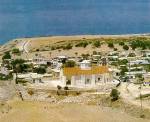 Click here to see an enlargement.
This is the Church of Ayios Georghios (Saint George) as it was before the Turkish invasion in 1974. The church was built during the 19th century and it was
inaugurated by Archbishop Sofronios the 19th of August 1880. Today the church is in a bad condition. The Church Icon Screen and the Icons were stolen or
destroyed. The doors, windows and stalls are all missing, just bare walls alone, were left and as the church is currently used as a stable, livestock excreta
within the church bare witness of the civil standards of the conquerors. Click here to see an enlargement.
This is the Church of Ayios Georghios (Saint George) as it was before the Turkish invasion in 1974. The church was built during the 19th century and it was
inaugurated by Archbishop Sofronios the 19th of August 1880. Today the church is in a bad condition. The Church Icon Screen and the Icons were stolen or
destroyed. The doors, windows and stalls are all missing, just bare walls alone, were left and as the church is currently used as a stable, livestock excreta
within the church bare witness of the civil standards of the conquerors.
|
 Click here to see an
enlargement. This is a view of Ayios Georghios Church during 1995. The crosses on the dome and the steeple were removed. A large part of the
roof tiles is missing and also the doors and the windows. The present day internal condition of the church was described in the previous
paragraph. Time is on duty for the rest .... Click here to see an
enlargement. This is a view of Ayios Georghios Church during 1995. The crosses on the dome and the steeple were removed. A large part of the
roof tiles is missing and also the doors and the windows. The present day internal condition of the church was described in the previous
paragraph. Time is on duty for the rest ....
|
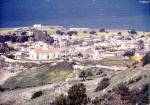 Click here to see an
enlargement. This is a view of Dhavlos from the hill "Kontaritis" which is above the village. In the background behind the Church of Ayios
Georghios, the most prominent feature of the village can be seen. This is a double row of pine trees along the main road through the village which leads to the
sea. The scenery is breathtaking as in this virgin land the wilderness of the sea merges with the beauty of the land in a harmonic combination. Click here to see an
enlargement. This is a view of Dhavlos from the hill "Kontaritis" which is above the village. In the background behind the Church of Ayios
Georghios, the most prominent feature of the village can be seen. This is a double row of pine trees along the main road through the village which leads to the
sea. The scenery is breathtaking as in this virgin land the wilderness of the sea merges with the beauty of the land in a harmonic combination.
|
 Click here to see an
enlargement. This is another view from "Kontaritis" when the sea is calm. This peaceful image has nothing to resemble the aggressiveness of the
conquerors which deprived the native inhabitants of the village to live in peace in the place they were born. Click here to see an
enlargement. This is another view from "Kontaritis" when the sea is calm. This peaceful image has nothing to resemble the aggressiveness of the
conquerors which deprived the native inhabitants of the village to live in peace in the place they were born.
|
 Click here to see an
enlargement. This is a view of the village from "Kontaritis" during 1973 when the native inhabitants of the village were still living in the
village and caring for it. Click here to see an
enlargement. This is a view of the village from "Kontaritis" during 1973 when the native inhabitants of the village were still living in the
village and caring for it.
|
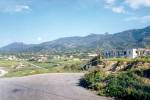 Click here to see an
enlargement. This is a view eastwards. The "Ais Photis" (Saint Photios) mountaintop can be seen in the distant vicinity. The Mineral Baths (Spa)
premises can be seen on the left and behind them a small tourist estate can also be seen. At the foreground at right the "Tony's" Hotel can be seen. Click here to see an
enlargement. This is a view eastwards. The "Ais Photis" (Saint Photios) mountaintop can be seen in the distant vicinity. The Mineral Baths (Spa)
premises can be seen on the left and behind them a small tourist estate can also be seen. At the foreground at right the "Tony's" Hotel can be seen.
|
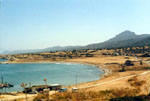 Click here to see an
enlargement. This is an eastwards view of the "Amalia Bay". The Mineral Baths (Spa) premises can be seen in the middle of the bay and behind them
a small tourist estate can also be seen. At the foreground on the left, the fish boat shelter and also the place where the mineral water spring emerges
can be seen. In the background the "Ais Photis" (Saint Photios) mountaintop
(right) and the "Yiouti" mountaintop (left) can be seen.
Click here to see an
enlargement. This is an eastwards view of the "Amalia Bay". The Mineral Baths (Spa) premises can be seen in the middle of the bay and behind them
a small tourist estate can also be seen. At the foreground on the left, the fish boat shelter and also the place where the mineral water spring emerges
can be seen. In the background the "Ais Photis" (Saint Photios) mountaintop
(right) and the "Yiouti" mountaintop (left) can be seen.
|
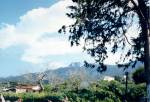 Click here to see an
enlargement. This is a view from the village towards South. In the center of the picture, in less than 4 miles from the village, the Kantara castle known
also as "Regaena Castle" or " Ekaton Spitia "( One Hundred Rooms) can be seen. The abundance of vegetation in the northern side of
Pendadaktylos Mountains is clearly distinguishable.
Click here to see an
enlargement. This is a view from the village towards South. In the center of the picture, in less than 4 miles from the village, the Kantara castle known
also as "Regaena Castle" or " Ekaton Spitia "( One Hundred Rooms) can be seen. The abundance of vegetation in the northern side of
Pendadaktylos Mountains is clearly distinguishable.
|
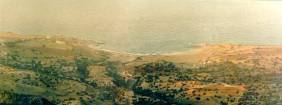 Click here to see an enlargement.
This is a view of the eastern bay of Dhavlos called "Amalia". The gulf is laid with reddish fine limestone sand and the beach is excellent for sea
baths. The Mineral Baths premises are in the center of the bay and the "Louis" and " Tony's" hotel in the left. In the left side of the gulf
which is called "Mahazeni" there is a fish boat shelter and also the mineral water spring emerges from there. In earlier years the carob stores which
were demolished around 1970 used to be in the same area. A similar bay called "Pachinas" exists on the west side of the village. Click here to see an enlargement.
This is a view of the eastern bay of Dhavlos called "Amalia". The gulf is laid with reddish fine limestone sand and the beach is excellent for sea
baths. The Mineral Baths premises are in the center of the bay and the "Louis" and " Tony's" hotel in the left. In the left side of the gulf
which is called "Mahazeni" there is a fish boat shelter and also the mineral water spring emerges from there. In earlier years the carob stores which
were demolished around 1970 used to be in the same area. A similar bay called "Pachinas" exists on the west side of the village.
|
 Click here to see an enlargement.
This is a view westwards from a locality called "Alonoudhkia". The Kantara mountains can be seen at the distant left. On the left the main village can
be seen and on the right, near the sea the Mineral Baths premises together with the "Louis" and "Tony's" hotels can be seen. Click here to see an enlargement.
This is a view westwards from a locality called "Alonoudhkia". The Kantara mountains can be seen at the distant left. On the left the main village can
be seen and on the right, near the sea the Mineral Baths premises together with the "Louis" and "Tony's" hotels can be seen.
|
 Click here to see an enlargement.
This is a view from Kantara Castle of the locality called Pyrgos (Tower). To the center - left of the picture is the Ayios Sozomenos chapel. Click here to see an enlargement.
This is a view from Kantara Castle of the locality called Pyrgos (Tower). To the center - left of the picture is the Ayios Sozomenos chapel.
|
 Click here to see an
enlargement. This is a view of Ayios Sozomenos (Saint Sozomenos) Chapel. It is located about two miles to the east of the village near the sea.
According to a traditional narrative the chapel was erected in this place after the icon of Ayios Sozomenos was found in the rocks in the front of the church,
near the sea. The erection of the chapel started in the position the icon was found, but strangely when the builders were returning the next morning to continue
their work, they were discovering that the previous day's work was demolished. This went on until one of the builders saw in his dream Saint Sozomenos telling
him that he did not like the place they were erecting the chapel, but was preferring the plateau above the cliff where his icon was found. The next morning the
builder told to his colleagues about his dream and after that, they changed the place where they were building the chapel to the place Saint Sozomenos showed
and so the chapel was able to be completed. Click here to see an
enlargement. This is a view of Ayios Sozomenos (Saint Sozomenos) Chapel. It is located about two miles to the east of the village near the sea.
According to a traditional narrative the chapel was erected in this place after the icon of Ayios Sozomenos was found in the rocks in the front of the church,
near the sea. The erection of the chapel started in the position the icon was found, but strangely when the builders were returning the next morning to continue
their work, they were discovering that the previous day's work was demolished. This went on until one of the builders saw in his dream Saint Sozomenos telling
him that he did not like the place they were erecting the chapel, but was preferring the plateau above the cliff where his icon was found. The next morning the
builder told to his colleagues about his dream and after that, they changed the place where they were building the chapel to the place Saint Sozomenos showed
and so the chapel was able to be completed.
Other Chapels of the village are the Ayia Ekaterini which is located within the village near the Ayios Georghios church
and the Ayios Nikolaos Chapel which is located in the southeast of the village just below Kantara Castle. This Chapel was formerly the Saint Nikolas monastery.
|
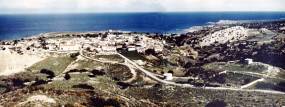 Click here to see an
enlargement. This is a wide angle view of the village from "Kontaritis" some years after the Turkish invasion and occupation of the village in
1974. Following the occupant's campaign for Destruction of the Cultural Identity of the
occupied Cyprus, the cemetery of the village was destroyed as it can be seen in the foreground at the right of the picture. The following text is
transferred here from the Times newspaper edition of 5.27.1976. Click here to see an
enlargement. This is a wide angle view of the village from "Kontaritis" some years after the Turkish invasion and occupation of the village in
1974. Following the occupant's campaign for Destruction of the Cultural Identity of the
occupied Cyprus, the cemetery of the village was destroyed as it can be seen in the foreground at the right of the picture. The following text is
transferred here from the Times newspaper edition of 5.27.1976.
The Times
"It is important to distinguish between random damage that might have been caused by drunks after a night out, and
the demolition of crosses, tombstones and heavy marble slabs which weigh several hundredweight and would need men with sledgehammers to destroy them. We found
nothing to fit the first category. In fact, at Dhavlos, on the north coast, now occupied by mainland Turks, even the graveyard wall was partly
demolished. Not a single tombstone remained standing...
..the process of obliterating everything Greek has been carried out methodically. The churches and graveyards have
suffered severely."
"The Times", 5.27.1976
|
 Click here to see an
enlargement. This is a view of Dhavlos a few years after the occupation of the village. In the desperate attempt of the conquerors to change the Greek
and Christian character of the village, a big Mosque, whose size is not in proportion to the number of the village's inhabitants, was erected in the center of
the village. Several houses in the area were demolished so as to gain adequate space to build the Mosque. In opposition to the new Mosque the Church of Ayios
Georghios is abandoned and today is in a much worse state from that seen on this photograph.
Click here to see an
enlargement. This is a view of Dhavlos a few years after the occupation of the village. In the desperate attempt of the conquerors to change the Greek
and Christian character of the village, a big Mosque, whose size is not in proportion to the number of the village's inhabitants, was erected in the center of
the village. Several houses in the area were demolished so as to gain adequate space to build the Mosque. In opposition to the new Mosque the Church of Ayios
Georghios is abandoned and today is in a much worse state from that seen on this photograph.
|

|